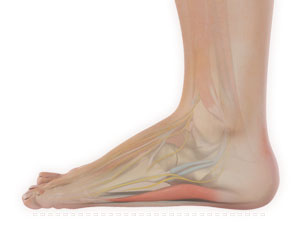Flatfoot- Adult

What is Flatfoot?
Flatfoot, also known as “fallen arches” or Pes planus, is a deformity in adult’s feet in which the arch that runs lengthwise along the sole of the foot has collapsed to the ground that was previously normal.
What are the Types of Flatfoot?
Flatfoot can be rigid or flexible. Flexible flatfoot usually resolves without any treatment needed unless pain is involved. Rigid flatfoot however, can cause joint pain in the leg when walking or an aching pain in the feet and usually requires intervention.
What are the Causes and Risk Factors for Flatfoot?
Adult flat foot is a common condition that could be idiopathic. It is often caused by loose connections between the joints and due to ligamentous laxity. Other common cause if failure of the Tibialis Posterior Tendon (Tibialis Posterior Tendon Insufficiency). This condition occurs due to wear and tear in the tendon and ultimately leads to failure of the midfoot and the arch collapses. Other common causes are inflammatory arthritis, diabetes and trauma.
What are the Symptoms of Flatfoot?
Adults with flatfoot deformity may have one or more of the following signs and symptoms:
- Significant pain
- Inside arch of the foot is flattened
- Heel bone may be turned outward
- Inner aspect of the foot may appear bowed out
- Pain in the foot, leg, knee, hip, or lower back
- Pain in the heels causing difficultly with walking/running
- Discomfort while wearing shoes
- Inability to bear weight on the affected foot
- Tired, achy feet with prolonged standing or walking
How is Flatfoot Diagnosed?
Your doctor will perform a physical examination of your foot and observe you in standing and sitting positions. If an arch form when you stand on his toes, then the flatfoot is flexible and no further tests or treatment are necessary. If pain is associated with the condition, or if the arch does not form on standing on the toes, then X-rays are ordered to assess the severity of the deformity. If a tendon injury is presumed, a magnetic resonance imaging (MRI) is recommended.
What are the Treatment Options for Flatfoot?
If you do not exhibit any symptoms, your doctor may monitor your condition as he/she grows to assess for any changes. If, however, you have symptoms, your doctor may suggest some of the following non-surgical treatments.
- Activity modification: Avoid participating in activities that cause pain such as walking or standing for long periods of time.
- Orthotic devices: Your surgeon may advise the use of custom-made orthotic devices that are worn inside the shoes to support the arch of the foot.
- Physical Therapy: Stretching exercises of the heel can provide pain relief.
- Medications: Pain relieving medications such as NSAIDs can help reduce pain and inflammation.
- Shoe modification: Using a well‐fitting, supportive shoe can help relieve aching pain caused by flatfoot.
Surgery is indicated when the nonoperative management fails. The surgery includes tendon transfer and heel bone realignment. In severe condition when you have arthritis, a fusion surgery is indicated.
Related Topics
- Bunions
- Stiff Big Toe (Hallux Rigidus)
- Toe Deformities
- Arthritis of Foot
- Plantar Fasciitis
- Morton's Neuroma
- Flatfoot-Adult
- Foot Fractures
- Paediatric Foot Conditions
- Lisfranc (Midfoot) Injury
- Calcaneal Fractures (Heel Fractures)
- Bunionette (Tailor's Bunion)
- Metatarsalgia
- Toe and Forefoot Fractures
- Foot Rheumatoid Arthritis
- Sesamoiditis
- Athlete's Foot
- Foot Stress Fractures
- Cavus Foot Deformity




